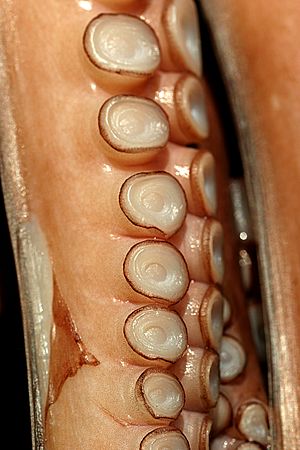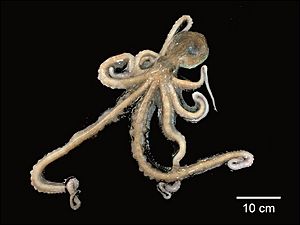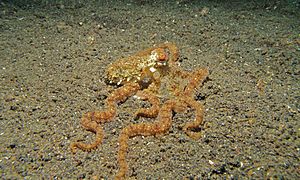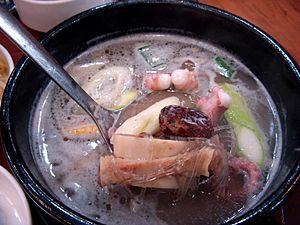Long arm octopus facts for kids
Quick facts for kids Long arm octopus |
|
|---|---|
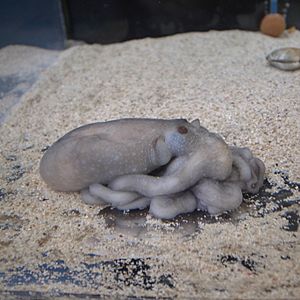 |
|
| Scientific classification | |
| Synonyms | |
|
The Octopus minor, also known as the long arm octopus or the Korean common octopus, is a small octopus. It lives in the coastal waters near Eastern China, Japan, and the Korean Peninsula. You can find it on the seafloor, from the surface down to about 200 meters (656 feet). O. minor often lives in the muddy areas of shallow ocean zones. This means it has to deal with big changes in its environment. It belongs to the group called Cephalopoda, which also includes squids and cuttlefish.
This octopus is important for the culture and economy in Asian countries where it lives. In Korea, it's a big part of the fishing industry, helping to make up a $35 million octopus business. It's a popular Korean seafood called nakji (낙지). People eat it both cooked and raw, and it's often a snack during sports events.
Scientists have learned a lot about how O. minor bodies work. It can carry a dangerous parasite. However, it can also change its body shape and color to fit different environments. These special abilities have made scientists very interested in this octopus, and its genome (its complete set of DNA) has been mapped.
Contents
Discover the Long Arm Octopus
The Octopus minor is a fascinating creature. It has a unique body structure and interesting ways of living.
What Does the Long Arm Octopus Look Like?
Like other octopuses, the O. minor has a body that is the same on both sides. It has two eyes and a mouth in the middle of its eight arms. Its arms are very flexible and have grown from what used to be its feet. These arms are connected by a web-like skin. Two-thirds of the octopus's brain cells are found in these arms!
On the underside of its arms, the O. minor has round, sticky suckers. These suckers help the octopus grab things, move around, and prepare its food. The octopus also has a main body part called the mantle, which holds most of its important organs. The name "Cephalopoda" actually means "head foot" because its arms (feet) are directly attached to its head.
The O. minor is a small, soft-bodied octopus with long arms, which is why it's called the long-arm octopus. It has a round head and eight arms. It's usually grey, which helps it blend in with the sandy seafloor. But if it feels threatened, it can quickly change its skin to a dark red color.
How Big is the Long Arm Octopus?
The main body of the O. minor can grow up to 18 centimeters (7 inches) long. Its arms can reach up to 65 centimeters (25.5 inches)! While that sounds big, it's quite small compared to some other cephalopods, like the colossal squid, which can be over 10 meters (33 feet) long.
Where Do Long Arm Octopuses Live and What Do They Do?
The O. minor lives in many different places and has special ways of finding food and moving around.
What Do Long Arm Octopuses Eat?
The O. minor is a hunter, just like other octopuses. Its diet is similar to other octopuses that live on the bottom of the ocean. More than half of what it eats is fish. About 25% of its diet is molluscs like whelks and clams. The rest of its food includes crustaceans like crabs, as well as annelids and nematodes. These are all common animals found where the O. minor lives. Because it's small, it doesn't eat larger animals like big rock scallops or large fish.
Since the O. minor lives on the seafloor, it can move easily between rocks and through small cracks. When it spots its prey, it suddenly pounces. It uses its suckers to grab the prey and pull it close. For smaller targets, the O. minor traps them in the web-like skin between its arms. It then injects a paralyzing saliva into its prey. It uses tiny teeth at the end of a special tube to break them apart. When hunting shelled molluscs, the O. minor uses a toxic saliva that helps break down the shell. Once the shell is open, the prey's muscles relax, allowing the octopus to remove its soft parts and kill it.
Male and female O. minor octopuses eat differently. Females eat less from April to July, which is when their eggs are developing. During this time, males eat more. Scientists have found 10 different types of animals in the O. minor's stomach, but a type of fish called Gobiidae was most common when females were developing their eggs.
How Do Long Arm Octopuses Move?
Unlike crabs, which have many limbs, the O. minor uses all eight of its arms independently to move. The way its muscles are arranged in its arms allows it to move in any direction. O. minor moves by crawling between rocks and through crevices. It also swims using its dorsal fin at the front. Jet propulsion is another way the O. minor moves. When crawling, it uses some suckers to grip the ground and pull itself forward with its arm muscles. Other suckers push from behind. It repeats this until it changes how it moves.
The O. minor swims by pushing water out of its mantle through a tube called a siphon. The force of the water pushes the octopus in the opposite direction. The direction it moves depends on where the siphon is pointing. The long arms of the O. minor give it a smooth, streamlined shape for swimming. Its body symmetry allows it to move headfirst, with its arms trailing behind. Jet swimming is mostly used to escape danger quickly.
The O. minor can also do a movement called "pumping." This is when its arms contract all at once, creating a wave that moves its body forward. The O. minor can even crawl outside of the water. It does this to move between tide pools or sometimes when it's served as a food!
Where Do Long Arm Octopuses Live?
The habitats of the O. minor can be very different. They live on rocky floors, reefs, and the ocean floor. It's a benthic octopus, meaning it lives at the very bottom of the water, near the sand, rocks, or coral. The O. minor is found in the mudflats of shallow ocean zones along the southwest coast of the Korean Peninsula. O. minor living in these muddy coastal areas have to deal with tough conditions, including changes in salinity (saltiness), temperature, and water movement. The O. minor also lives in rocky places like Jeju Island, a large island in South Korea.
The O. minor is often found in the Yellow Sea. This part of the Western Pacific Ocean is located between the Korean Peninsula and mainland China. It's connected to the Gulf of Bohai. The Yellow Sea is over 950 kilometers (590 miles) long from north to south and 700 kilometers (435 miles) wide. The sea has a circular current and two high tides and two low tides each day. Temperatures can range from -10 degrees Celsius (14°F) to 28 degrees Celsius (82°F).
How Do Long Arm Octopuses Change Color?
When O. minor octopuses are hunting or hiding from predators, they use special pigment-filled sacs called chromatophores. These are in their skin and allow the octopus to change its color or how much light it reflects. Chromatophores can be red, brown, black, grey, yellow, or blue. The octopus can also use shiny iridescent skin tissue to communicate with other octopuses or during courtship rituals.
The O. minor has muscles on its mantle that can change its skin texture to help with color changes. Because the O. minor lives in shallow waters, it has developed more varied skin patterns than other cephalopods.
Long Arm Octopuses and Humans
The O. minor is very important in the Korean fishing industry. A large amount, over 350,000 tonnes, is caught each year. This makes it a key ingredient in many special seafood dishes, especially in Korea. Because the octopus can adapt so well to tough living conditions, scientists have studied it a lot and even mapped its genome.
How Do People Eat Long Arm Octopuses?
In most parts of Korea, O. minor, or Nakji, is a popular food. It's often served as a snack, either raw, cooked, or poached.
Nakji-bokkeum (Cooked Octopus)
For this dish, the O. minor is chopped and then stir-fried with vegetables like carrots, onions, and cabbage. It's marinated in a Korean red pepper sauce. This dish is served hot with warm rice, somyeon noodles, or bean sprouts.
San-nakji (Raw Octopus)
For this dish, the O. minor is served raw on a plate, either chopped or whole. It's often eaten with sesame oil and sesame seeds. The arms of the O. minor have many nerve endings and a complex nervous system. This means they can still move a lot even after being separated from the brain. Because the suction cups on the arms are still active, they might stick to a person's throat. This means there's a risk of choking for those who eat it.
Nakji-yeonpo-tang (Octopus Soup)
For this dish, the O. minor is boiled in broth. Then, it's chopped into small pieces and served in the soup with spring onion, chilli, and minced garlic. This soup is traditionally served during funeral processions.
Are There Any Dangers from the Long Arm Octopus?
About 22% of O. minor octopuses have been found to carry a dangerous parasitic crustacean called Octopicola huanghaienis. The octopus is more likely to get this parasite because it doesn't have an outer shell, unlike snails. This parasite has a spike at the end of its mouth part. The parasite can be a health concern if the O. minor is eaten raw.
Genetic Research on the Long Arm Octopus
The O. minor's ability to change its behavior to fit different habitats made it a great animal to study. Scientists wanted to map its genome. Studies of O. minor found in the Korean Peninsula and Eastern China showed genetic differences between octopuses from different places. The Yellow Sea connects the borders of these countries. Scientists looked at the CO1 gene to study the genetic makeup of O. minor because this gene changes faster.
Mapping the Octopus's Genes
Scientists studied the body shape of the O. minor to map its genome. They looked at its ability to handle environmental changes. They also studied how it develops and adapts at a molecular level. The complete genome of the octopus was found to be 5.09 billion base pairs long, with over 30,010 genes. About 44% of its genome was made up of repeated genetic elements. The O. minor has 178 total gene families. A very similar DNA sequence found in many species suggests that O. minor might actually be the same species as Callioctopus ornatus and Callioctopus luteus, even though they live in different places.


